Slovenian Economic Mirror
Related Files:
Slovenian Economic Mirror 4/2024
Manufacturing output recovered in April after a significant decline in March and is now close to the level of the first two months of the year. In the first four months, it was similar to the same period last year. Trade in goods decreased month-on-month in April but increased year-on-year. In the first four months, exports and imports of goods remained on average lower year-on-year. Sentiment in export-oriented activities improved in May, although export orders remained at a very low level. After stagnating in the first quarter, real turnover in most trade sectors increased month-on-month in April and was also higher year-on-year. According to preliminary data, year-on-year growth of durable goods consumption continued. After high growth at the beginning of last year, construction activity has gradually declined amid monthly fluctuations. The economic climate deteriorated slightly month-on-month in May, while it improved year-on-year for the second consecutive month. As inflation eases, consumers are much more optimistic compared to the same period last year. Year-on-year inflation was 2.5% in May, the lowest since September 2021, primarily due to service prices. At the end of May, 6.6% fewer people were unemployed than in the same period last year. Despite slowing growth rates, wage growth remains relatively high amid labour shortages.
Related Files:
- International environment
- Economic trends
- Labour market
- Prices
- Financial markets
- Balance of payments
- Public finance
Contributions to GDP growth in the euro area, Q1 2024
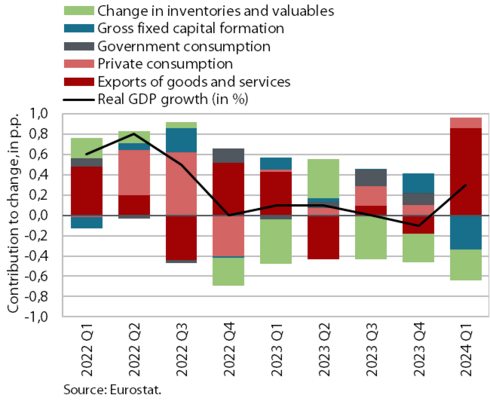
The euro area economy recovered in the first quarter and the ECB expects continued growth in subsequent quarters. Net trade and private consumption contributed to the 0.3% quarter-on-quarter economic growth (0.4% year-on-year) in the first quarter. According to available indicators, similar economic growth is expected to persist into the second quarter. The composite Purchasing Managers’ Index (PMI) for the euro area further strengthened in May, reaching a one-year high (52.2), supported by services, while the manufacturing PMI continues to indicate contraction. According to June ECB staff projections, GDP growth is expected to be 0.9% in 2024, strengthening to 1.4% in 2025 and 1.6% in 2026. Amid wage growth and rising confidence, real disposable income is expected to continue increasing, supporting private consumption, which will be the main driver of economic growth. Foreign demand is expected to continue to expand, supporting export growth. Euro area inflation continued to fall in the first five months of the year, and the ECB expects it to decline further. It therefore decided to lower the key interest rates by 25 basis points at its June meeting. The ECB forecasts HICP inflation of 2.5% this year, falling further to 2.2% in 2025 and 1.9% in 2026 as cost pressures continue to ease.
Commodity prices, May 2024
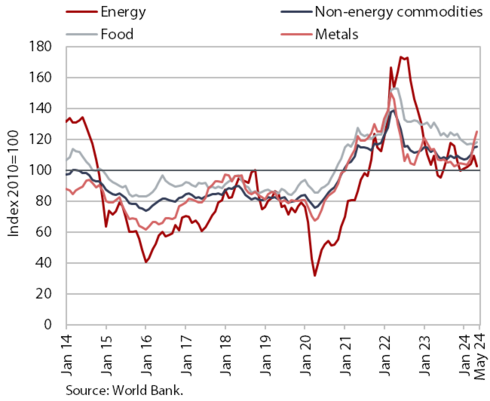
The Brent oil price declined in May but was higher year-on-year; prices for non-energy commodities were also higher year-on-year but unchanged compared to April. After gradually increasing since the beginning of the year, the average dollar price of Brent crude oil declined in May, reaching USD 81.8 (an 8.8% decrease compared to April). The average euro price also fell, reaching EUR 75.7 (a 9.5% decrease compared to April). Year-on-year, the dollar price of Brent oil increased by 8% and the euro price rose by 8.8%. At 31.94 EUR/MWh, the euro prices of natural gas on the European market (Dutch TTF) were higher in May than in April (by 10.6%) and similar to prices a year ago. According to the World Bank, the average dollar price of non-energy commodities remained unchanged in May compared to April. Among the main commodity groups, prices of metals and minerals, in particular, saw a notable increase (up by 5.5%). After nearly two years of decline, prices of non-energy commodities where higher year-on-year for the second consecutive month in April (by 5.1%). Prices of beverages, especially cocoa, and metals and minerals in particular were higher (by 62% and 16% respectively).
Short-term indicators of economic activity in Slovenia, March−April 2024
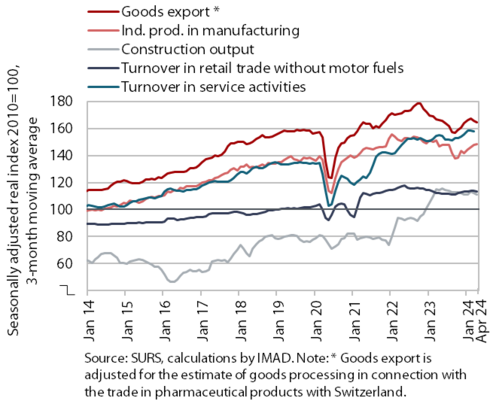
According to economic indicators for Slovenia, activity in manufacturing and trade improved at the beginning of the second quarter. Manufacturing output recovered in April after a significant decline in March and is now close to the level of the first two months of the year. Compared to the previous April, it was 8.2% higher. In the first four months of the year, it was similar to the same period last year. Trade in goods decreased month-on-month in April but increased year-on-year. In the first four months, exports and imports of goods remained on average lower year-on-year. Sentiment in export-oriented activities improved in May, although export orders remained at a very low level. After stagnating in the first quarter, real turnover in most trade sectors increased month-on-month in April and was also higher year-on-year. According to preliminary data, year-on-year growth of household consumption of durable goods continued, with turnover in the sales of motor vehicles and retail sales of non-food products rising by 22.3% and 5.6% respectively year-on-year. Total real turnover in market services continued to rise in the first quarter and was also higher year-on-year. According to data on the value of construction work put in place, construction activity fell in April and was also down year-on-year. The economic sentiment indicator fell slightly month-on-month in May, although it remained higher year-on-year for the second consecutive month. Compared to the same period last year, consumers are much more optimistic as inflation eases.
Electricity consumption by consumption group, May 2024

Electricity consumption in the distribution network was lower year-on-year in May in all consumption groups. With the same number of working days, industrial consumption in May was 4.1% lower year-on-year, as was consumption by small business customers. As in recent months, household consumption was lower year-on-year in May (by 7.5%), which may also have been influenced by higher end prices for electricity due to higher network charges, changes in consumption billing (90:10) and higher VAT.
Value of fiscally verified invoices – nominal, May 2024
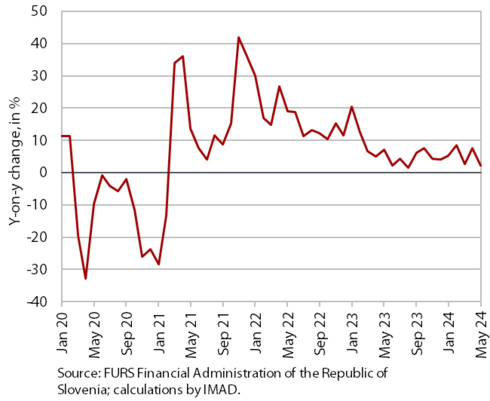
The nominal value of fiscally verified invoices was 2% higher year-on-year in May. After rising in April (by 8%), year-on-year growth of total turnover weakened significantly. Growth of turnover in trade, which accounted for more than three-quarters of the total value of fiscally verified invoices, moderated from 7% to 1%. Turnover growth in retail trade remained relatively strong (5%), while turnover in the sales of motor vehicles and wholesale trade fell year-on-year after rising in April. Year-on-year turnover growth in accommodation and food service activities and in certain creative, arts, entertainment, and sports services and betting and gambling remained high (total growth in accommodation and food service activities and other service activities was 11%).
Trade in goods – in real terms, April 2024
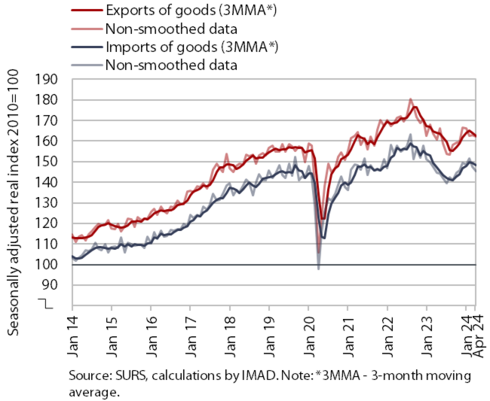
In April, trade in goods declined month-on-month but increased year-on-year. Real seasonally adjusted exports of goods fell by 0.4% and imports by 1.5%. The decline was due to trade with non-EU countries, while exports to and imports from EU Member States increased slightly (trade with France in particular increased, while trade with Austria and Italy declined). Exports of most main product groups increased, while exports of primary products and of metals and metal products were lower. Imports of consumer goods fell for the third consecutive month, while imports of intermediate goods rose, reaching the highest level since the beginning of the year (seasonally adjusted). In the first four months, exports and imports of goods (including with EU Member States) were still on average lower year-on-year (by 1.6% and 1.2% respectively). Sentiment in export-oriented activities improved in May, although export orders remained at a very low level.
Trade in services – nominal, April 2024
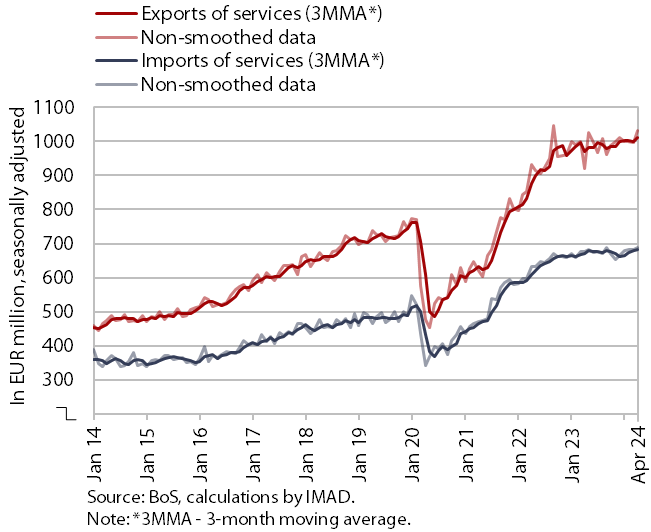
Trade in services increased month-on-month in April and was also higher year-on-year. Exports of services increased mainly due to robust growth in other business services, which otherwise fluctuate significantly from month to month. Among the main service groups, exports of transport and tourism-related services also rose. Imports of services also increased, mainly due to higher imports of tourism-related services (seasonally adjusted). Both exports and imports of services were higher in the first four months than in the same period last year, mainly due to the strong growth in exports of some important service groups (transport, ICT and other business) in April compared to the previous year. Exports and imports of tourism-related services also remained higher in April than last year, but their year-on-year growth is slowing.
Production volume in manufacturing, April 2024
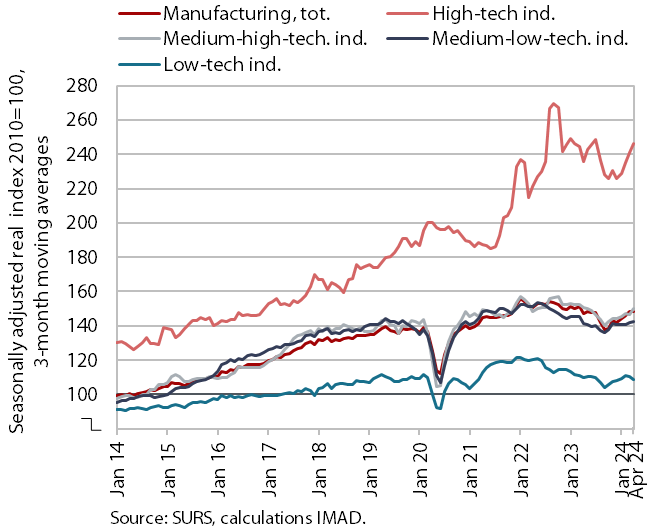
Manufacturing output recovered in April after a significant decline in March and is now close to the level of the first two months of the year. Production recovered above all in the more technology-intensive industries, while production in the less technology-intensive industries in April was still below the level at the beginning of the year. Compared to the previous April, manufacturing output was 8.2% higher (with three more working days this April). In the first four months of the year, it was similar to the same period last year (with large monthly fluctuations). Production in the energy-intensive chemical industry and manufacture of other non-metallic mineral products n.e.c. and in some less technology-intensive industries remained down year-on-year. The production of machinery and equipment n.e.c. was also lower.
Activity in construction, April 2024
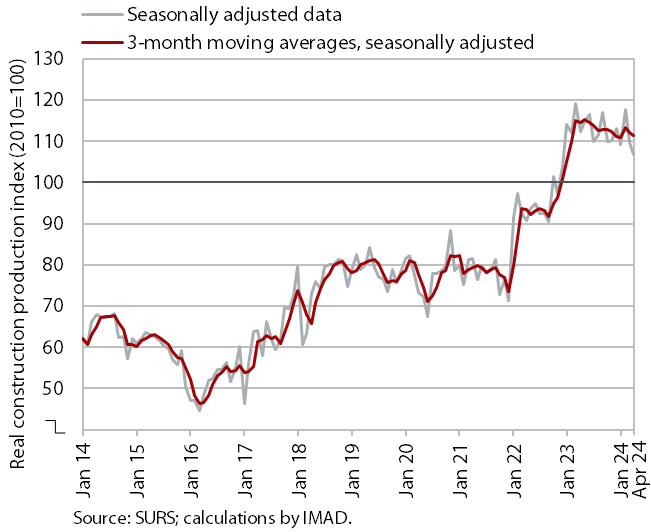
According to data on the value of construction work put in place, construction activity fell in April and was also down year-on-year. After strong growth at the beginning of last year, activity gradually declined amid monthly fluctuations. In April, construction activity was 5% lower compared to the same month last year. The largest year-on-year decline in activity was recorded in civil engineering (by 8%). Activity also declined in the construction of buildings and specialised construction activities.
Some other data, however, point to growth in construction activity. According to VAT data, the activity of construction companies in April was 4% higher than last year. Compared with data on the value of construction put in place, the difference shown in the growth of this activity was thus 9 p.p.
Turnover in trade, March–April 2024
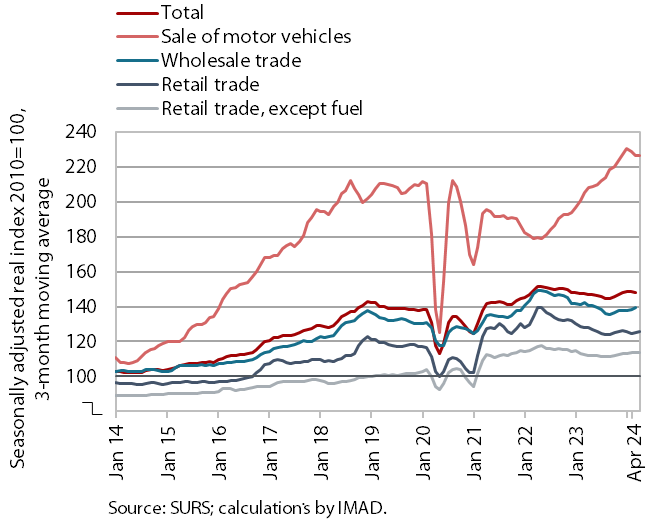
After stagnating in the first quarter, real turnover in most trade sectors increased month-on-month in April, according to preliminary data, and was also higher year-on-year. In the first quarter, only turnover in wholesale trade increased quarter-on-quarter, while it was lower year-on-year (-1%) for the fifth consecutive quarter. Turnover in retail sales of non-food products was also down year-on-year (-1%), while turnover in retail sales of food, beverages and tobacco rose year-on-year (by 4%). Following strong growth last year, turnover in the sales of motor vehicles is stagnating this year, while it was still significantly higher year-on-year (by 9%). According to preliminary data from SURS, turnover in most sectors picked up in April and, with three more working days than in April last year, was also higher year-on-year.
Turnover in market services, March 2024
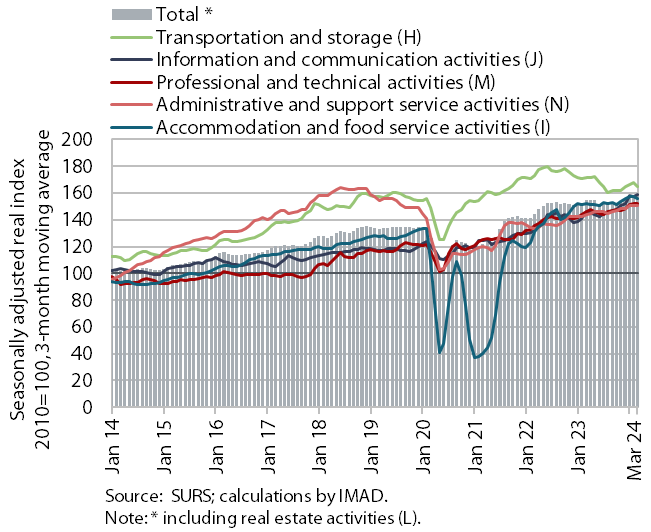
Total real turnover in market services continued to rise in the first quarter (by 1.5%) and was also higher year-on-year (by 1.2%). Turnover growth in information and communication accelerated compared to the previous quarter, with sales of computer services increasing, particularly in the domestic market. Turnover growth also accelerated in professional and technical activities, driven by continued growth in architectural and engineering services. Turnover growth in administrative and support service activities slowed somewhat, despite a renewed growth in employment services. With a higher number of overnight stays, turnover in accommodation and food service activities was similar to the level recorded at the end of last year, as was the case in transportation and storage. In the first quarter, total real turnover in market services was only lower year-on-year in transportation and storage.
Selected indicators of household consumption, April 2024
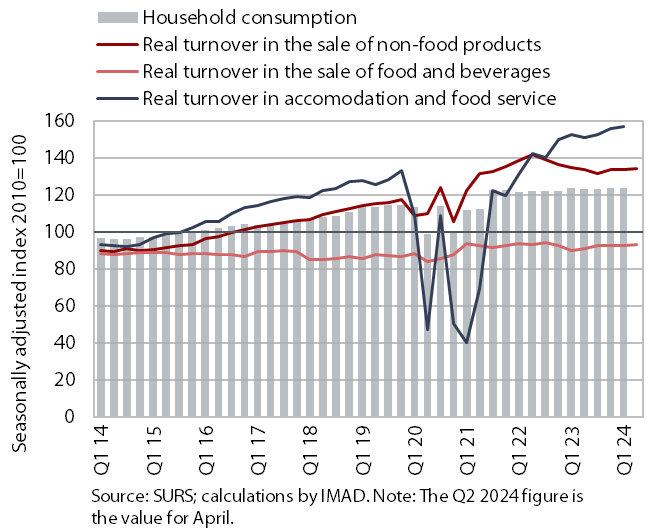
At the beginning of the second quarter, household consumption of durable goods continued to rise year-on-year, according to preliminary data. In April, turnover in the sales of motor vehicles and retail sales of non-food products rose by 22.3% and 5.6% respectively year-on-year. Turnover in retail sales of food, beverages and tobacco was similar to April last year.
Economic sentiment, May 2024
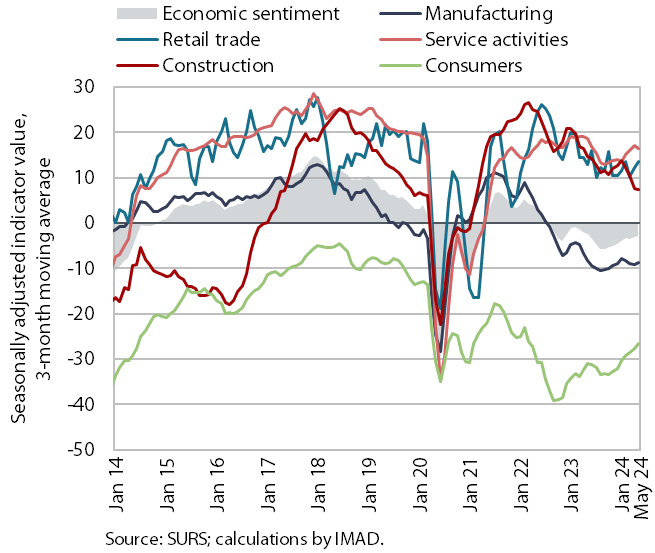
The economic sentiment indicator fell slightly month-on-month in May, although it remained higher year-on-year. The monthly decline was due to lower confidence indicators in retail trade and service activities, while confidence increased in construction and manufacturing and remained unchanged among consumers. Economic sentiment improved year-on-year for the second consecutive month. With inflation easing, consumers are much more optimistic than they were a year ago and in particular had higher expectations regarding the household financial situation in May. Sentiment in manufacturing was also better than in the same period last year, with higher indicators for expected production and exports. Sentiment in construction was significantly lower but still above the long-term average.
Number of persons in employment, March 2024
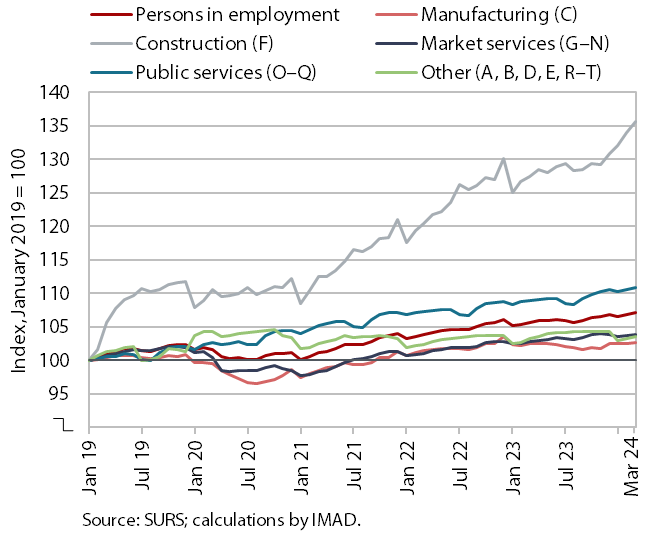
The number of persons in employment continued to rise year-on-year in March. Growth was similar (1.4%) to the first two months of this year and higher than in the last months of 2023. The acceleration was mainly due to a change in the definition of persons in employment, which now also includes workers posted abroad. Growth was the highest in construction, which faces great labour shortages, and the increase was further boosted by the aforementioned change in the definition of the labour force. The year-on-year increase in the total number of persons in employment was due to a higher number of employed foreign nationals, while the number of employed Slovenian citizens fell. The share of foreign citizens among all persons in employment was 15.6% in March, 1.4 p.p. higher than a year earlier. Notably, the activities with the largest shares of foreign workers were construction (50%), transportation and storage (33%), and administrative and support service activities (29%).
Number of registered unemployed, May 2024
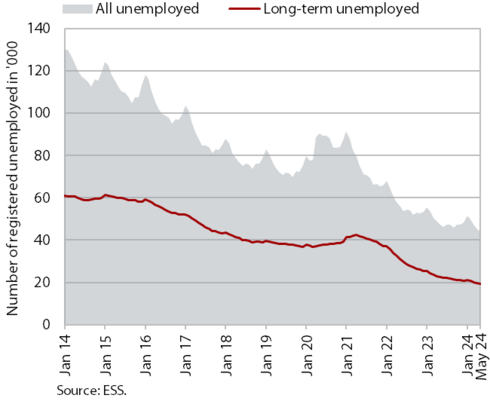
The monthly decline in the seasonally adjusted number of registered unemployed in May (0.7%) was slightly lower than in previous months. According to original data, 44,088 people were unemployed at the end of May, 6.6% less than a year ago. Amid labour shortages, the number of long-term unemployed (more than one year) and the number of unemployed over 50 fell year-on-year at the end of May, by 14.5% and 8.8% respectively. In the first five months, just over 1% of the unemployed moved to inactivity or retirement each month, also contributing to the decline in unemployment.
Active and inactive population, Q1 2024

According to survey data, the number of unemployed was lower year-on-year in the first quarter of this year, while the number of persons in employment increased. Thirty-six thousand persons were unemployed, which is 5.3% less than in the first quarter of last year. The survey unemployment rate (3.4 %) fell by 0.4 p.p. year-on-year. As economic activity continued to increase in the first quarter of this year, the year-on-year increase in the number of persons in employment (3.2%) was more pronounced than in previous quarters. This growth was mainly driven by increases in employees in labour relation and the self-employed.
Average real gross wage per employee, March 2024
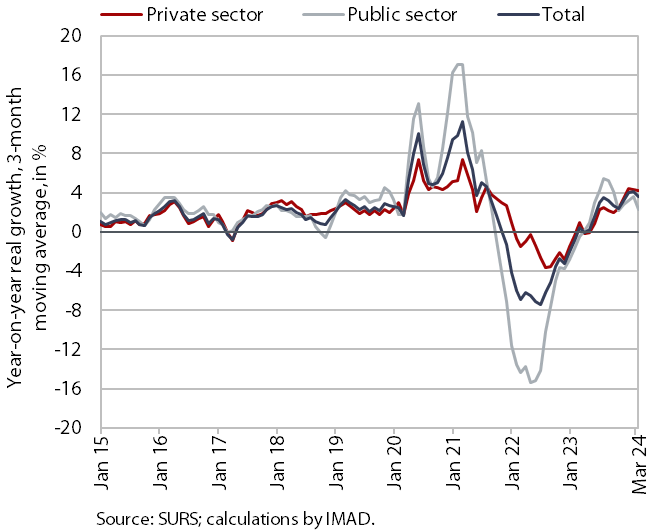
In March, the average gross wage growth (2.7%) was slightly lower in real terms compared to the first two months of the year. With inflation slightly higher, this was mainly due to the high base effect from last year, when the minimum wage saw a larger increase at the beginning of the year compared to this year. In the private sector, the average gross wage in March increased by 3.5% year-on-year in real terms, with the highest growth recorded in administrative and support service activities and manufacturing. Real growth in the public sector was 1.3%. Nominal year-on-year growth in the average gross wage (6.4%) was slightly lower than in previous months. It increased by 7.2% in the private sector and by 5% in the public sector. In the first three months, it was on average 7.1% higher in nominal terms, which is less than in previous quarters.
Consumer prices, May 2024
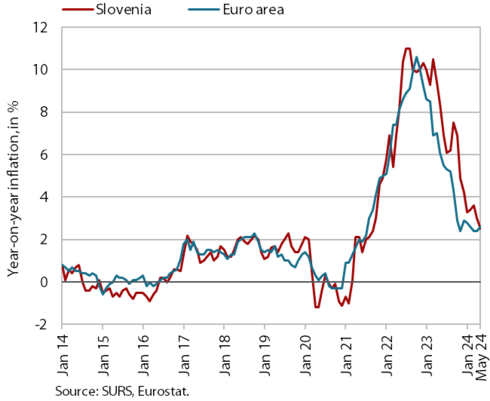
Year-on-year growth in consumer prices fell for the second consecutive month in May, reaching 2.5%, the lowest level since September 2021. Prices rose by 0.5% month-on-month, but the increase was half the five-year May average and also the lowest for this period. The moderation of year-on-year growth was mainly due to almost one-third lower price growth in the group housing, water, electricity, gas and other fuels (3.1%) compared to previous months. Year-on-year price growth in alcoholic drinks and tobacco (4.2%) was also lower, attributed to a higher base last year due to an increase in excise duties on tobacco. Prices of food and non-alcoholic beverages were 0.2% lower year-on-year after stagnating in April. Year-on-year growth in prices of semi-durable goods remained roughly unchanged (1.7%), while prices of durable goods continue to fall year-on-year (-0.9%). Growth in service prices further moderated (4.1% year-on-year). Among all groups of goods and services, the strongest year-on-year price increases were still recorded in restaurants and hotels (6.8% year-on-year) and education (6%).
Slovenian industrial producer prices, April 2024
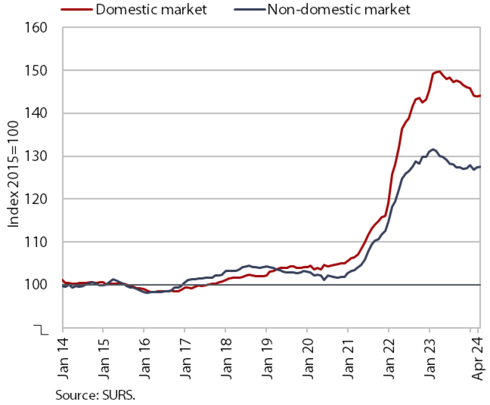
In April, industrial producer prices increased slightly month-on-month for the second consecutive month (0.1%), while the year-on-year decline continued to narrow slightly (-2.9%). The month-on-month growth was driven by a 0.5% increase in prices of consumer goods (mainly durable goods, which rose by 1.6%), while prices of capital goods and raw materials remained unchanged. Energy prices fell by 0.5% month-on-month due to lower prices for coke and petroleum products (-2.7%). Year-on-year, the decline in prices of raw materials (-5.5%) and energy (-9.4%) slowed slightly, while the rise in prices of capital goods (0.7%) and consumer goods (1.2%) accelerated. Industrial producer prices fell by 3.8% year-on-year on the domestic market and by 1.9% on foreign markets. The smaller decline on foreign markets was mainly due to higher prices on non-euro-area markets (2.7%), while the decline in prices in the euro area (-3.6%) was comparable to the decline on the domestic market.
Loans to domestic non-banking sectors, April 2024
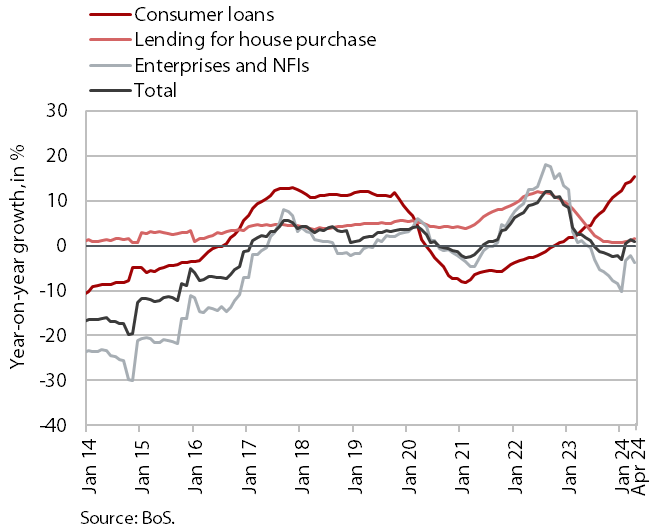
In April, year-on-year growth in the volume of loans to the domestic non-bank sector fell slightly (0.9%) amid a higher base, though it increased month-on-month. This slowdown was due to a sharper year-on-year decline in the volume of corporate and NFI loans, which remained comparable to the end of the previous year (-5.3%). Growth in household loans continued to strengthen (5%), with consumer loans already up 15.5% year-on-year in April. In the first four months, new consumer loans amounted to slightly above EUR 530 million, almost 50% higher than the same period last year. Year-on-year growth of housing loans increased slightly, though it remained relatively modest (1.5%). Year-on-year growth in non-banking sector deposits (3.2%) remained largely unchanged in April. The volume of term deposits increased by more than 35% year-on-year. The volume of overnight deposits fell by 3.3% compared to April last year, with their share declining by 5 b.p. (to 78%). The quality of banks’ assets remains solid, with the share of non-performing loans unchanged at 1% in the first quarter.
Current account of the balance of payments, April 2024
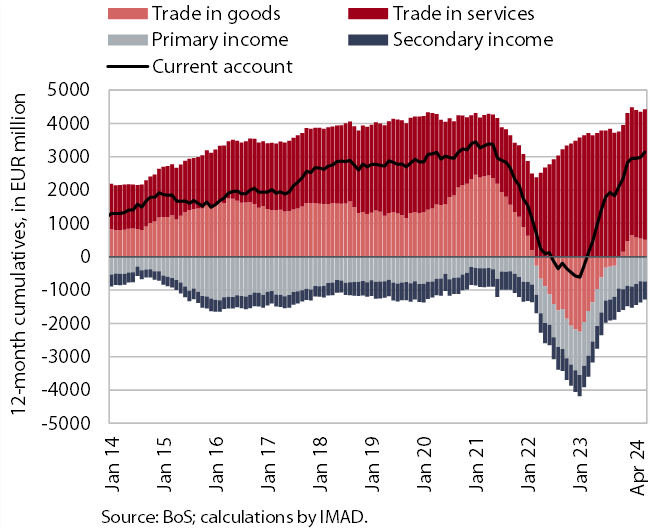
The 12-month current account surplus increased compared to the previous 12-month period, reaching EUR 3.1 billion (4.7% of estimated GDP). This increase was mainly driven by the improved goods balance, as imports declined more sharply than exports. The surplus in trade in services widened, especially in trade in processing, transport, construction and financial services. Primary and secondary income also contributed to the improvement of the current account balance. The primary income deficit decreased due to lower net outflows of income from equity capital (dividends and profits) and higher net interest receipts by the Bank of Slovenia from deposits in foreign accounts. The secondary income deficit decreased due to higher private sector transfers (payments of non-life insurance premiums) and higher net positive transfers to the government sector from abroad (funds for current international cooperation from the EU budget).
Revenue of the consolidated general government budgetary accounts, April 2024 (top figure) and expenditure of the consolidated general government budgetary accounts, April 2024 (bottom figure)
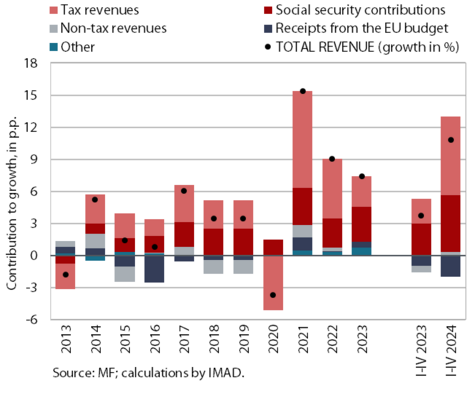
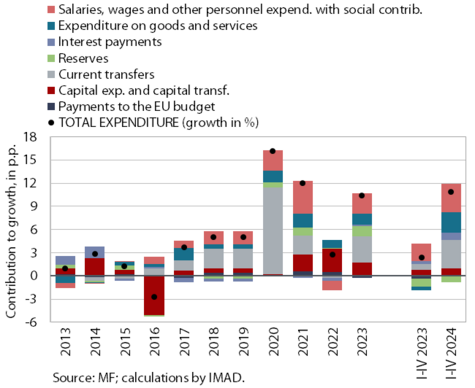
In the first four months of this year, the deficit of the consolidated balance of public finances was slightly higher year-on-year. It totalled EUR 55 million, compared with EUR 44 million in the same period last year. Revenue increased by 10.8% year-on-year. In the first four months of this year, alongside the increase in revenue from social contributions due to the transformation of the complementary health contribution into a mandatory contribution, revenue from corporate income tax picked up significantly, driven by higher balancing payments of tax this year. Personal income tax revenues also saw significant growth, influenced partly by the non-adjustment of the income tax scale and tax relief to inflation. Growth in non-tax revenues was also higher due to higher revenue from profit sharing, dividends and surplus of revenues over the expenditure. Growth in revenue from excise duties was low due to the dynamics of adoption of measures to mitigate the consequences of rising energy prices and also last year’s late payment by some excise registrants. Total receipts from the EU budget were lower year-on-year. In the first four months of the year, expenditure increased by 10.9% year-on-year. The main contributors were expenditure on salaries, wages and other personnel expenditure, and the early payment of the holiday allowance, the increase in expenditure on goods and services and other healthcare expenditure in connection with the transformation of the supplementary health insurance into a mandatory contribution, as well as transfers to individuals and households, partly as a result of the high regular annual indexation of pensions. Contribution from investment and interest expenditure was slightly lower. From August 2023 to the end of April 2024, EUR 672.3 million had been disbursed from the state budget to rectify the consequences of floods and landslides, of which EUR 114.2 million was disbursed in the first four months of this year, most of it for ongoing maintenance and insurance under the emergency Flood Recovery Act.
EU budget receipts, April 2024 (top figure) and absorption of 2014–2020 ECP funds (EU part) for the period 1 January 2014–30 April 2024 (bottom figure)
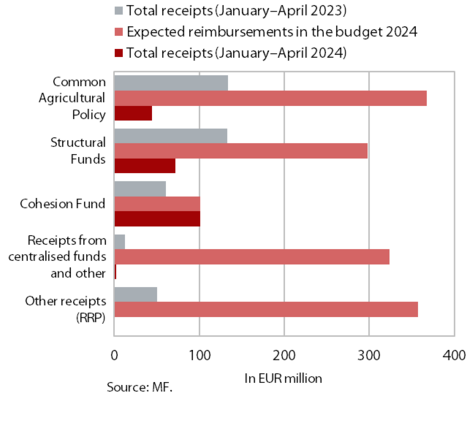
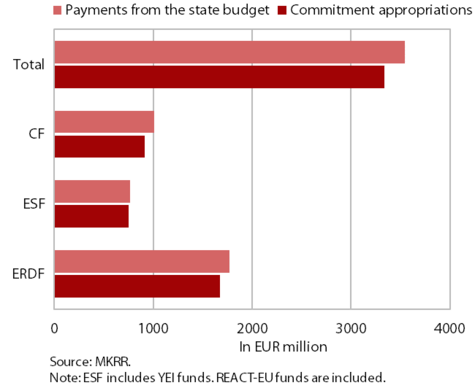
Slovenia’s net budgetary position against the EU budget was positive in the first four months of 2024 (at EUR 41.2 million). In this period, Slovenia received EUR 237.7 million from the EU budget (16.4% of receipts envisaged in the adopted state budget for 2024) and paid EUR 196.5 million into it (27.3% of planned payments). The bulk of receipts (42.6% of all reimbursements to the state budget, 100.5% of the planned reimbursements in 2024) were resources from the Cohesion Fund and from structural funds (30.3% of all reimbursements to the state budget, 24.2% of the planned reimbursements in 2024). Receipts for the implementation of the Common Agricultural and Fisheries Policies amounted to 18.8% of all reimbursements (12.2% of the planned reimbursements in 2024). The highest payments into the EU budget came from GNI-based payments (46.1% of all payments).
According to the MKRR data, under the Operational Programme for the Implementation of EU Cohesion policy 2014–2020 (from January 2014 to the end of April 2024), payments from the state budget totalled EUR 3.54 billion (EU share), which corresponds to 106% of the available funds, while certain payments from the state budget are planned for the first half of 2024 (about EUR 66 million according to estimates made by line ministries).Under the Operational Programme for the Implementation of EU Cohesion policy 2021–2027 (from January 2021 to the end of April 2024), payments from the state budget totalled EUR 25.8 million (EU share), which corresponds to 1% of the available funds.
